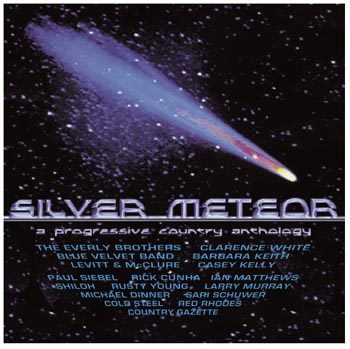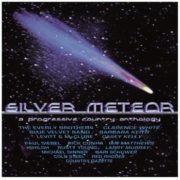SILVER METEOR (A PROGRESSIVE COUNTRY ANTHOLOGY)
ARTIST: VARIOUS ARTISTS
TITLE: SILVER METEOR (A PROGRESSIVE COUNTRY ANTHOLOGY)
LABEL: SIERRA RECORDS SXCD 6032
RELEASE DATE: JUNE 2010
 Los Angeles was the home of the invention of country rock in the late 1960s, and for almost a decade this genre flourished and made millions of dollars for the major record companies. The Eagles were probably the most famous of the groups that played country rock, although only their first record and portions of the next few really mined this genre.
Los Angeles was the home of the invention of country rock in the late 1960s, and for almost a decade this genre flourished and made millions of dollars for the major record companies. The Eagles were probably the most famous of the groups that played country rock, although only their first record and portions of the next few really mined this genre.
The original release of Silver Meteor (on Sierra as well) was back in 1980. It served not only as a great overview of LA country rock music including some now almost forgotten artists, but it also featured the four songs that the late Clarence White recorded for his first solo album. Sadly, this project was not completed since a few weeks after these recordings were done, White was killed by a drunk driver while loading his equipment following a gig in Palmdale.
White was one of the first bluegrass guitarists to use his instrument for more than rhythm. He created his own style, incorporating elements of Doc Watson’s flatpicking and fingerpicking. White listened to and revered gypsy swing guitarist Django Reinhardt, and was very interested in Reinhardt’s ability to “play” with the boundaries of standard musical time. Some of White’s work sounds as if it is heading out of the song’s timing, but always returns in a delightful manner. White’s bluegrass work is legendary, partly for this reason.
Acoustic music faded considerably when the British Invasion and San Francisco sound took over the music charts. In order to garner more work, White picked up the electric guitar, eventually landing in the Byrds. White had played in a number of LA based electric county bands at this point, and he had created a very pedal steel like sound. The Byrds has morphed from their folk rock stage through their psychedelic stage to their country stage, and now with Roger McGuinn as the sole original member, the Byrds final few albums include a lot of country rock. White’s work emulating the pedal steel guitar ultimately led to White and Byrds’ drummer Gene Parsons inventing the Parsons/White Stringbender. This device allows the guitarist to pull his guitar down enough to engage levers attached to the guitar’s strap button. This instigates a series of levers that pull the “B” string of the guitar to pre-set tunings, sounding very much like a pedal steel guitar. White’s work not only provided the Byrds with their most effective lead soloist, but he also played on a variety of other artist’s projects, some of which are captured on Silver Meteor. The efforts of Sierra Records’ founder/owner John Delgatto have been primary in keeping White’s music alive. There is also an excellent website forum for White’s admirers.
White contributes four songs to Silver Meteor. These cuts are fine examples of a time when folk, rock, bluegrass and swing could all exist in the same song. Most of these songs have appeared in different forms on either one of White’s acoustic projects like The White Brothers Live in Sweden, a Rounder Records release that has inexplicably not been released on CD, or his involvement in the Muleskinner project/record. Clarence is in excellent voice on these cuts, and the harmonies provided by Herb Pedersen and Roland White are sterling, though not necessarily standard bluegrass harmony. Their vocal work takes some of bluegrass and melds it with pop. This creates something that is perhaps as evocative of the Beach Boys as Bill Monroe. White’s guitar work is amazing, whether acoustic or electric. And, as always, guitar serves the song rather than being a forum for his hot licks. His solo on Tom Paxton’s Last Thing on My Mind is more reminiscent of Mother Maybelle Carter than White’s usual hot picking, but suits the song perfectly.
Silver Meteor combines other very well known artists like the Everly Brothers with a variety of lesser known musicians. The Everlys handle two songs, one of which is a remarkably fluid country rock version of Cuckoo Bird that tends to stagger the imagination: for once, they overdubbed Phil’s second harmony, and created a new sound for them that was more roots and folk oriented. Unfortunately, like most of their fine later work, this did not bring them the accolades or sales deserved. Another group featured on Silver Meteor is Country Gazette. They may not have the profile of some of today’s Alison Krause-like bluegrass groups, but as somewhat of an acoustic, bluegrass based spin-off of the Flying Burrito Brothers, they provided one of the most innovative and enjoyable bluegrass groups of the era. Country Gazette applied more of the elements of rock to their sound than some of their contemporaries, and although the two songs included in this collection may not be their best or most popular, they do a fine job of showcasing how underrated this band is in the pantheon of country rock and bluegrass.
Silver Meteor hits a major nostalgia note for many folk music fans in LA with the inclusion of Levitt and McClure’s version of Pete Seeger’s Living in the Country. For many years, a live version of this song served as the theme to Howard and Roz Larman’s KPFK Folkscene radio program. Silver Meteor features the song Pinto Pony by Paul Siebel. One could wish that Siebel’s She Made Me Lose My Blues was included as well, since that song served for quite some time as the theme for John Davis’ late, lamented KPFK folk music program. Siebel is another of those great “lost” artists, and Pinto Pony showcases Siebel’s pithy story telling lyric style, as well as White’s playing.
Other artists include Casey Kelly, who provides the title cut and Michael Dinner, a fine writer who was saddled with the “new Dylan” mantle. There are three other esoteric favorites: the New England/East Coast hillbilly hotshots of the Blue Velvet Band; Red Rhodes, the brilliant pedal steel guitarist who recorded and played with Michael Nesmith’s First National Band; and Ian Matthews, a Brit country rocker with a beautiful high voice and an uncanny knack for finding great songs to record.
The updated version of Dr. Bill Koon’s original liner notes are almost worth the price of admission. Not only are the musician’s names and instruments listed for almost all the songs, but a history of the era and the names of many artists who are not included in this recording help tie together this genre and time.
Huge kudos to John Delgatto not only for providing this wonderful piece of history, but also his for his apparently tireless efforts since the heyday of this music to keep it available and into the hands of the folks who enjoy it.
Dennis Roger Reed is a singer-songwriter, musician, and writer based in San Clemente, CA. He is apparently somewhat of an expert on Gram Parsons, with his writings on the subject having been featured in Mojo and in God’s Own Singer: A Life of Gram Parsons by Jason Walker. Writing about his music has appeared in Acoustic Musician, Bass Player, Bluegrass Now, Bluegrass Unlimited, Blues Access, Blues Revue, Blue Suede News, Dirty Linen, the LA Times, Living Blues, and Sing Out! He is still decidedly not famous.













